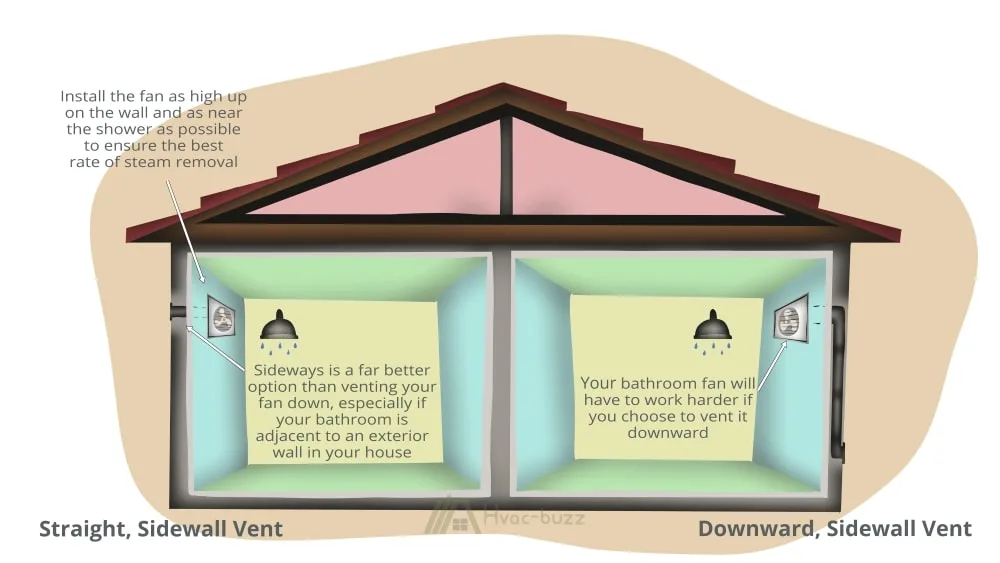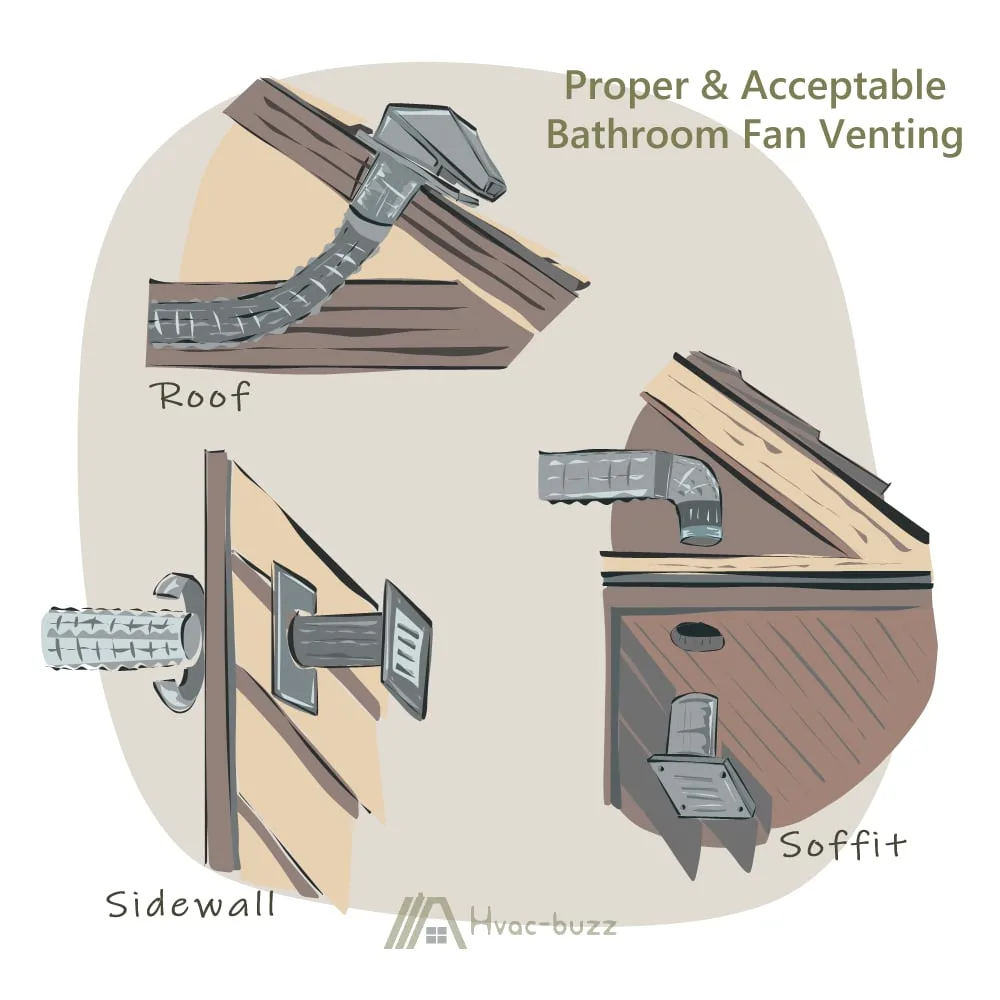When you install a fan in your bathroom, you want it to work at its optimal best. So it’s important that vent it in the most effective way. All the ductwork involved in venting a bathroom fan can make the job a tricky one, but there is something worse: venting incorrectly and having to do it all over again!
Most people vent up, but there are some websites out there that say venting down is the most effective method. To me, this claim just does not make any sense. Keep reading and I will take you through all the things you need to consider when venting your fan in a particular direction, as well as some of the science behind venting down and what this means practically.

Bathroom fans can be vented down as long as the length of the ductwork does not exceed the allowable length specified in the building codes. The vents will also still have to terminate outside the house. Venting down goes against the natural flow of hot and humid air, so your fan will have to work harder.
Downward Venting Is Not a Code Violation
As far as I can see, there are no rules or building codes against venting downward. However, it still has to be vented outside and not into another room according to the International Residential Code Section 1501.1 which states:
“The air removed by every mechanical exhaust system shall be discharged to the outdoors in accordance with Section M1506.3. Air shall not be exhausted into an attic, soffit, ridge vent or crawl space.
Don’t Put the Fan on the Floor
The bathroom fan is there to pull steam out of the bathroom, improve the indoor air quality, and reducing moisture levels. The clouds of steam generated by a shower or bath naturally rise upwards, so installing the fan on the floor will certainly not give you the most efficient result.
There’s also a danger of things falling through the grid vent and blocking the motor or dirtying the blades. At best, this will reduce the effectiveness of the fan and cause it to make a noise. At worst, it will severely damage the motor or interfere with the wiring and cause an electrical fire!
Furthermore, installing a fan on the floor means that it can be exposed to a lot more water than it is designed to withstand. This water can compromise the fan’s electrical system, causing it to short circuit or blow a fuse. It can also result in premature rusting of the fan components and casing.
Fan Requirements
Installing the fan on your wall will be a better choice (I am making the assumption that you do not want to or cannot install it on the ceiling, which is one of the reasons you wish to vent down).
Most wall insert fans are too loud for a residential building. In addition, most wall insert fans vent straight out through the wall (venting neither up nor down).
However, you should also be able to use a ceiling insert fan on a wall and then vent it in the direction you choose. Install the fan as high up on the wall and as near to the shower as possible to ensure the best rate of steam removal.
While buying a bathroom fan, make sure to choose one that’s suitable for the size of your bathroom and is of high enough quality that it will last a long time. You can read my article on Who Makes the Best Bathroom Exhaust Fans for my recommendation.

Duct Length Requirements
Whether you vent up, down, or to the side, you can only vent a certain distance before the ductwork becomes too extensive to allow for efficient exhausting of bathroom air.
Have a look at my Bathroom Fan Duct Length and Dimension Guide for the correct lengths and how to adjust for the inclusion of elbows.
Vent Termination Options With Venting Down
Depending on where your bathroom is situated, you can vent down and out the sidewall, the soffit, or the rim joists.

Pros of Venting a Bathroom Fan Down
If the design and layout of your house leave you with no other option but to vent your bathroom fan down (such as limited ceiling space above a small bathroom), then you will be happy to know that there is one major (and not insignificant) benefit to venting downwards as opposed to up through the roof.
You don’t have to cut a hole in your roof, compromising its water-tightness.
Cons of Venting a Bathroom Fan Down
You are making your bathroom fan work harder if you choose to vent it downward. When you have a warm/hot shower, the moisture-containing hot air will naturally rise, so pushing it down through the ductwork can become quite taxing for the fan.
Choosing to vent the bathroom fan downward can also increase your chances of structural damage as it leads to faster moisture build-up that causes corrosion.
If You Can’t Vent up, Can You Vent Sideways?
Sideways is a far better option than venting your fan down, especially if your bathroom is adjacent to an exterior wall in your house. To vent sideways, you need to install the fan in the wall and vent it through the wall instead of venting it through the roof or the soffit.
Sometimes, the only place to vent through the wall is under a deck or porch. This is possible but it also comes with a set of issues, so you will have to weigh these against the issues associated with venting down and make your decision from there.
If your bathroom has an external wall, then you can go for a through-the-wall fan like the Panasonic FV-08WQ1 WhisperWall (amazon link) is one of the only wall insert fans on the market that is quiet enough to be used in a residential building. A notable benefit of this fan is that there is almost no ductwork involved.
A second option is a low-profile wall insert fan like the Panasonic FV-0510VS1 WhisperValue is meant for vertical installation as it’s not as thick as a normal fan and can fit comfortably between wall studs. You can then run the ductwork out through the nearest external wall or soffit.
- Smart Ventilation: ECM motor with SmartFlow technology senses static pressure for ideal CFM output
- Pick-A-Flow Speed Selector: Select desired airflow from 50, 80, 110 CFM
- Precision spot ventilation fan, ideal for residential construction (single and multifamily) and manufactured homes
- Optional built-in Multi-Speed Control for ASHRAE 62.2 compliance
Last update on 2024-03-29 / Affiliate links / Images from Amazon Product Advertising API
Is It Just a Toilet?
If your bathroom is just a toilet and all you want to do is control the odor then other methods may also be sufficient, such as installing a ductless fan. Quiet and energy-efficient, ductless bathroom fans mitigate and eliminate bathroom odors quite efficientlyly.
- VERSATILE FAN: Ventilation fan helps eliminate , tobacco smoke, and cooking odors. Install the compact fan between ceiling joists or wall studs - wherever it's needed most!
- EFFICIENT: Fan circulates air past replaceable activated charcoal filter to continually cycle the air in enclosed spaces
- EASY INSTALLATION: Includes fast snap-in metal housing for a quick and simple installation
- DECORATIVE: White polymeric grilles are the perfect addition to your existing decor
Last update on 2024-03-28 / Affiliate links / Images from Amazon Product Advertising API
Bad-smelling toilet rooms can be quite an embarrassment for you if you are hosting guests at home. No matter how fancy a bathroom looks, persistent bad odor is horrible. The presence of an odor-eliminating fan can also make your guests more comfortable.
Other alternatives include placing an air freshener, using an air purifier, and keeping the window open.
For more information and ideas, you can have a read through my article on 8 alternatives to an exhaust fan for odor control.
Sources
https://www.plumbworld.co.uk/blog/everything-you-need-to-know-about-bathroom-ventilation
https://www.bobvila.com/articles/bathroom-ventilation/
https://www.thisoldhouse.com/bathrooms/21247447/improve-bathroom-ventilation


